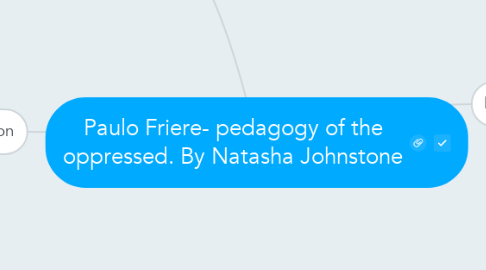
1. Banking education
1.1. 'Education as the practice of domination'
1.2. Teachers remain superior to students, and resist adapting curriculum for students.
1.3. Resists dialogue in teaching and learning
1.3.1. Teachers create curriculum students sit and listen to them.
1.3.1.1. Can impact on memory, because the students are not getting physically and mentally involved in the learning.
1.4. Disregards creativity, and focuses more on a traditional way of learning.
1.5. History
1.5.1. Seeks to conceal the existence of humans
1.5.2. Does not acknowledge humans as historical beings.
1.6. The teachers are the ones who have the knowledge and the students are the ones who learn from them.
1.7. Consciousness
1.7.1. In banking education, humans are not considered conscious beings.
1.8. Necrophilic
1.8.1. The banking education eliminates the chance of using creativity and therefore tries to eliminate thinking and acting upon thoughts.
2. Referencing: Paulo Freire, 1993, pedagogy of the oppressed, New York: Continuum Books
3. Problem posing education
3.1. 'Education as the practice of freedom'
3.2. Teachers learn from students. Although they create a curriculum, they can adapt it if they feel they need to, or if a student comes up with a way to improve the curriculum.
3.2.1. Disregards the word 'authority'
3.3. Problem posing education is all about dialogue- getting students to participate and talk to one another. This improves interaction and problem solving skills.
3.4. Based on creativity. Teachers urge children to get involved and use their creative sides to complete work.
3.4.1. The green hat
3.4.2. The Green Hat focuses on creativity, and using the imagination to complete tasks. 'possibilities, alternatives and new ideas'
3.4.3. Reference: http://www.debonothinkingsystems.com/tools/6hats.htm
3.4.4. Being challenged increases commitment from students because they develop a level of understanding.
3.5. Problem posing attempts to make students critical thinkers. Instead of them sitting and listening, problem posing gets students involved and gets everyone thinking.
3.6. Problem posing respects history, and starts by examining historicity.
3.6.1. Focuses on how humans exist within the world, and how we are related to the world.
3.7. Consciousness
3.7.1. Humans are infant conscious beings and are related to the world, they are present on earth.
